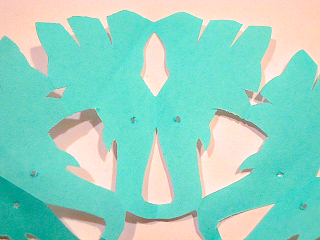It was snowing heavily here today. Alas, still not the right kind of snow for snowmen or snowballs—perfect weather, however, for sitting inside and making a paper snowflake elephant.
There is very little information about the origins of paper snowflakes, although most sources suggest that they are a product of the Victorian era. Generally six-sided like real snowflakes, they can be made of virtually any kind of paper, from tissue paper and coffee filters to wallpaper. Paper snowflakes are usually two-dimensional, although there are apparently ways of making them three-dimensional by throwing in a few origami folds. Given my previous experience with origami, we'll take that off the table right away for today's elephant.
I have never been able to make a successful paper snowflake in my life, so this should be interesting. Somehow I fold them wrong and end up with misshapen snowflakes cut in half, or eight-sided snowflakes, or even four-sided snowflakes. However, I found a tutorial online that promises "perfect snowflakes every time", so here goes.
Because you have to start with a square piece of paper, I decided to start with a 15 x 15 cm
(6 x 6 inch) sheet of origami paper—one, because it's pretty; two, because it's already square; and three, because it would otherwise go to waste.
The first thing you do is fold it in half.
Then in half again, but then unfold.
From here, it started to get complicated for my tiny brain. I persevered, but I am apparently totally inept when it comes to folding paper. Why this should be, I have no idea. I can rewire a lamp and replumb a sink, but I can't fold paper. Some sort of weird disconnect starts to happen the moment I read words that I can't match to the illustration. An apparently simple instruction such as, "Fold the left side from the top center to the right so that the upper left corner just touches the fold farthest to the right," makes me want to shoot myself.
After several attempts, I finally got what I believed to be the basic six-panelled shape. Much origami paper was sacrificed in this noble cause.
And now, because I most emphatically did not want to fold another one of these, I decided to think about the design before I made a single cut. This was supposed to be an elephant profile.
Sadly, I was to get quite good at the folding part. This is because I was not good at the design and cutting part. None of the instructions tell you how to cut to make a recognizable design. "Nibble away at the edges" is not helpful.
I finally figured out that the closed side with the single fold, rather than the open side with multiple folds, is the place to concentrate your design. As you can see, it took me a while to get the hang of this. I also had to learn not to chop away everything at the pointy end, because if I did, the snowflake was wide open in the middle, and very floppy.
Eventually I had something I didn't despise. Much more origami paper was sacrificed in this equally noble endeavour. But I've decided that I will never bedeck my windows with paper snowflakes at Christmas. Real snowflakes are more than enough for me.
Elephant Lore of the Day
Elephants, although often made to paint for tourists, do not have to fold paper snowflakes. Ever. This is likely because they lack opposable thumbs which, to my mind, makes them quite fortunate.
To Support Elephant Welfare
World Wildlife Fund
World Wildlife Fund
Elephant sanctuaries
(this Wikipedia list allows you to click through to information on a number of sanctuaries around the world)

























